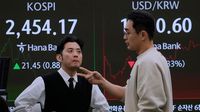The U.S. dollar has plunged to its lowest level in three years, primarily driven by renewed criticism from former President Donald Trump directed at Federal Reserve Chair Jerome Powell. This latest development comes amid escalating trade tensions and growing concerns over the independence of the Federal Reserve, leading to a significant exodus from U.S. assets.
As of April 22, 2025, the ICE U.S. Dollar Index fell to 97.92, marking a steep decline attributed to Trump’s aggressive rhetoric and calls for interest rate cuts. In a post on Truth Social, Trump labeled Powell as "a major loser" and insisted that the economy would slow unless Powell acted swiftly to lower interest rates. This sentiment has not only rattled investors but has also raised alarms regarding the political influence over monetary policy.
Market analysts have noted that Trump's attacks on Powell are contributing to a lack of confidence in U.S. markets. Tony Sycamore, a market analyst at IG, stated that the contentious relationship between Trump and Powell has long been a source of instability. Despite appointing Powell in 2017, Trump has frequently criticized him for decisions he deems unfavorable. "The market reaction is arguably more about broader investor concerns that less credible U.S. policy-making may erode the exorbitant privilege that has allowed the U.S. to run high twin deficits," explained Jim Reid, a market strategist at Deutsche Bank.
In the wake of Trump’s comments, the Dow Jones Industrial Average suffered a significant drop, losing 1,221 points (3.1 percent). The S&P 500 and Nasdaq Composite also experienced losses of 3.3 percent and 3.6 percent, respectively. Stocks of major tech firms, including Tesla and Nvidia, fell by 7 percent and 6 percent. Meanwhile, Amazon and Meta Platforms both saw declines of around 4 percent.
Adding to the market turmoil, the U.S. Dollar Index (DXY) is trading near 98.10, reflecting persistent weakness amid ongoing trade negotiations with China. The index has struggled to regain momentum after a sharp breakdown last week, with immediate resistance resting at $98.52 and support levels at $97.93. Traders are closely monitoring upcoming remarks from Federal Open Market Committee (FOMC) members, which may provide insights into the Fed's future policy direction.
In the context of these developments, the Pound Sterling has surged to a seven-month high against the U.S. dollar, reaching levels above 1.3400. Analysts suggest that the deteriorating confidence in the U.S. dollar has played a significant role in this currency shift. The Euro has also appreciated, hitting 41-month highs above 1.1550. Gold prices have soared to record levels, surpassing $3,500 per ounce, as investors seek refuge in safe-haven assets during these turbulent times.
China’s response to Trump’s tariff strategies has further complicated the situation. The Chinese government has issued strong counter-warnings, stating that "appeasement will not bring peace" and asserting that efforts to undermine their interests will ultimately fail. This ongoing deadlock in trade negotiations has left investors anxious about the potential for an economic slowdown.
As the economic landscape evolves, the Federal Reserve faces mounting pressure to navigate slowing growth alongside persistent inflation. Powell has acknowledged the challenges ahead, warning that a sluggish economy combined with inflationary pressures could pose risks of stagflation. The Richmond Manufacturing Index is forecasted to dip to -6, reinforcing concerns about regional economic softness.
In addition to these economic indicators, the U.S. Department of Labor reported a decline in initial jobless claims to 215,000 for the week ending April 12, 2025, which is below expectations. However, continuing jobless claims rose to 1.885 million, indicating potential underlying issues in the labor market.
Internationally, the Australian Dollar has also gained ground against the U.S. dollar, trading near 0.6420. This rise is attributed to investor sentiment shifting in response to the uncertainty surrounding U.S. monetary policy. The AUD/USD pair is maintaining its upward momentum, with immediate resistance seen at a four-month high of 0.6408.
As the situation continues to unfold, the implications of Trump's rhetoric and the potential for changes in Fed leadership remain critical areas of focus for investors. The possibility of Powell’s removal has been discussed, with White House economic advisor Kevin Hassett noting that Trump is exploring his authority to dismiss the Fed Chair. This uncertainty regarding Fed independence is crucial, as it could fundamentally alter the perception of U.S. monetary policy and its ability to maintain price stability.
Overall, the convergence of these factors has created a precarious environment for the U.S. dollar and the broader financial markets. Investors are left grappling with questions about the future direction of U.S. economic policy and its impact on global markets.
As April progresses, it is shaping up to be one of the worst months for U.S. stocks since the Great Depression, with the Dow Jones Industrial Average on track for its worst April performance since 1932. The S&P 500's performance since Inauguration Day is also the worst for any president in a similar timeframe, according to Bespoke Investment Group.








